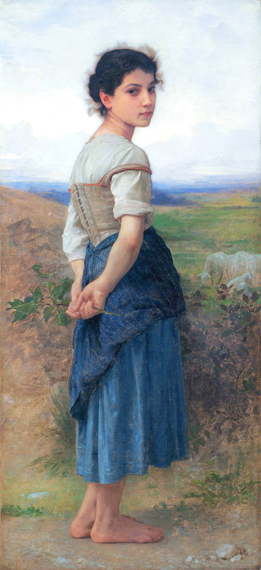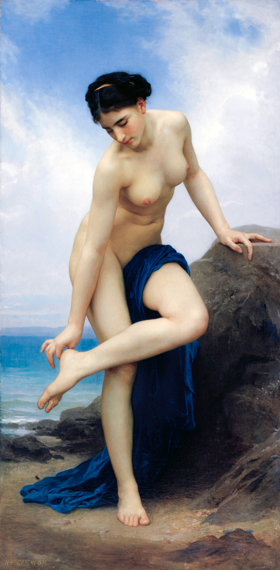5% Off Sitewide | Use code KMUS5 on checkout
- Choose your Country
5% Off Sitewide | Use code KMUS5 on checkout
William-Adolphe Bouguereau
William-Adolphe Bouguereau (30 November 1825 – 19 August 1905) was a dominant figure in his nation’s academic painting during the second half of the 19th century. In his realistic genre paintings he used mythological themes, making modern interpretations of classical subjects, with an emphasis on the female human body. During his life, he enjoyed significant popularity in France and the United States, was given numerous official honors, and received top prices for his work.
William-Adolphe Bouguereau was born in La Rochelle, France, on 30 November 1825, into a family of wine and olive oil merchants. At the age of twelve, Bouguereau went to Mortagne-sur-Gironde to stay with his uncle Eugène, a priest, and developed a love of nature, religion and literature. In 1839, he was sent to study for the priesthood at a Catholic college in Pons. Here he was taught to draw and paint by Louis Sage, who had studied under Ingres. Bouguereau reluctantly left his studies to return to his family, now residing in Bordeaux. There he met a local artist, Charles Marionneau, and commenced at the Municipal School of Drawing and Painting in November 1841. He was soon the best pupil in his class, and decided to become an artist in Paris. To fund the move, he sold portraits – 33 oils in three months. All were unsigned and only one has been traced. In 1845, he returned to Mortagne to spend more time with his uncle. He arrived in Paris in March 1846, aged twenty.
Bouguereau entered the École des Beaux-Arts in 1846 and was awarded the Prix de Rome in 1850. Upon his return to France from four years’ study in Italy, he attracted a wide following with his mythological and allegorical paintings, although his portrait paintings are perhaps held in higher esteem today. His work was characterized by a highly finished, technically impeccable realism and a sentimental interpretation of his subject matter.
Bouguereau, painting within the traditional academic style, exhibited at the annual exhibitions of the Paris Salon for his entire working life. An early reviewer stated, “M. Bouguereau has a natural instinct and knowledge of contour. The eurythmie of the human body preoccupies him, and in recalling the happy results which, in this genre, the ancients and the artists of the sixteenth century arrived at, one can only congratulate M. Bouguereau in attempting to follow in their footsteps … Raphael was inspired by the ancients … and no one accused him of not being original.”
From the early 1870s, he and his family spent every summer in La Rochelle. In 1882, he decided that rather than rent he would purchase a house, as well as local farm buildings. By August of that year, the family’s permanent summer base was on the rue Verdière. The artist commenced several paintings here and completed them in his Paris studio. Bouguereau flourished after his Villa Medici residence. In 1856, the Ministry of State for Fine Arts commissioned him to paint Emperor Napoleon III Visiting the Victims of the Tarascon Flood.
By the late 1850s, he had made strong connections with art dealers, particularly Paul Durand-Ruel (later the champion of the Impressionists), who helped clients buy paintings from artists who exhibited at the Salons. Thanks to Durand-Ruel, Bouguereau met Hugues Merle, who later often was compared to Bouguereau. Bouguereau’s fame extended to England by the 1860s. Three paintings were shown at the 1863 Salon and Holy Family (Now at Chimei Museum) was sold to Napoleon III, who presented it to his wife the Empress Eugénie.
Bather (1864), a shocking nude, was submitted to an exhibition in Ghent, Belgium. It was a spectacular success and purchased by the museum at great expense. At this time, William took on decorative work at the Grand Théâtre, Bordeaux, which lasted four years. In 1875, with assistants, he began work on a La Rochelle chapel ceiling, producing six paintings on copper over the next six years. Once installed in the city in summer 1875 he began Pietà, one of his greatest religious paintings and shown at the 1876 Salon, in tribute to his son Georges.
Bouguereau was a staunch traditionalist whose genre paintings and mythological themes were modern interpretations of Classical subjects, both pagan and Christian, with a concentration on the naked female form. The idealized world of his paintings brought to life goddesses, nymphs, bathers, shepherdesses, and madonnas in a way that appealed to wealthy art patrons of the era. He employed traditional methods of working up a painting, including detailed pencil studies and oil sketches, and his careful method resulted in a pleasing and accurate rendering of the human form. His painting of skin, hands, and feet was particularly admired. He also used some of the religious and erotic symbolism of the Old Masters, such as the “broken pitcher” which connoted lost innocence.
Bouguereau was an assiduous painter, often completing twenty or more easel paintings in a single year. Even during the twilight years of his life, he would rise at dawn to work on his paintings six days a week and would continue painting until nightfall. Throughout the course of his lifetime, he is known to have painted at least 822 paintings. Many of these paintings have been lost.
On 19 August 1905, aged 79, Bouguereau died in La Rochelle from heart disease. Bouguereau was laid to rest with Nelly and his children at the family vault at Montparnasse Cemetery.
Prices for Bouguereau’s works have climbed steadily since 1975, with major paintings selling at high prices: $1,500,000 in 1998 for The Heart’s Awakening, $2,600,000 in 1999 for The Motherland. Bouguereau’s works are in many public collections. His painting La Charité (1878) sold in 2000 for an auction record of $3.53 million at the time at Christie’s New York.
Read moreShowing 1–100 of 233 results

The Heart’s Awakening 1982
By William-Adolphe BouguereauSizes starting at $389.00
Songs of Spring 1889
By William-Adolphe BouguereauSizes starting at $389.00
Dream of Spring 1901
By William-Adolphe BouguereauSizes starting at $409.00
The Assault 1898
By William-Adolphe BouguereauSizes starting at $429.00
The Invasion 1892
By William-Adolphe BouguereauSizes starting at $409.00
Youth (1893)
By William-Adolphe BouguereauSizes starting at $439.00
Whisperings of Love 1889
By William-Adolphe BouguereauSizes starting at $439.00
Blessures d’amour 1897
By William-Adolphe BouguereauSizes starting at $459.00
The Birth of Venus (1879)
By William-Adolphe BouguereauSizes starting at $409.00
L’Amour et Psych (1899)
By William-Adolphe BouguereauSizes starting at $379.00
The rapture of Psyche 1895
By William-Adolphe BouguereauSizes starting at $399.00
Cupid’s Secrets 1896
By William-Adolphe BouguereauSizes starting at $339.00
L’Aurore (Dawn) 1881
By William-Adolphe BouguereauSizes starting at $419.00
Night (La Nuit) 1883
By William-Adolphe BouguereauSizes starting at $419.00
Lost Pleiad (1884)
By William-Adolphe BouguereauSizes starting at $439.00
Hemera 1881
By William-Adolphe BouguereauSizes starting at $419.00
Bacchante 1894
By William-Adolphe BouguereauSizes starting at $389.00
A Girl Defending Herself against Eros 1880
By William-Adolphe BouguereauSizes starting at $339.00
The Pony-Back Ride
By William-Adolphe BouguereauSizes starting at $329.00
Le Voile
By William-Adolphe BouguereauSizes starting at $339.00
Mailice (1899)
By William-Adolphe BouguereauSizes starting at $339.00
The Virgin of the angels 1881
By William-Adolphe BouguereauSizes starting at $409.00
The Flagellation of Our Lord Jesus Christ (1880)
By William-Adolphe BouguereauSizes starting at $409.00
Dante and Virgile 1850
By William-Adolphe BouguereauSizes starting at $379.00
The Motherland 1883
By William-Adolphe BouguereauSizes starting at $459.00
Pietà 1876
By William-Adolphe BouguereauSizes starting at $439.00
Virgin of Consolation
By William-Adolphe BouguereauSizes starting at $409.00
Virgin and Child
By William-Adolphe BouguereauSizes starting at $439.00
The Madonna of The Roses
By William-Adolphe BouguereauSizes starting at $379.00
La Vierge aux anges 1900
By William-Adolphe BouguereauSizes starting at $429.00
Ora Pro Nobis 1903
By William-Adolphe BouguereauSizes starting at $439.00
Orestes Pursued by the Furies
By William-Adolphe BouguereauSizes starting at $389.00
The First Mourning 1888
By William-Adolphe BouguereauSizes starting at $369.00
The Wave (1896)
By William-Adolphe BouguereauSizes starting at $319.00
Admiration 1897
By William-Adolphe BouguereauSizes starting at $399.00
The Nymphaeum
By William-Adolphe BouguereauSizes starting at $409.00
The Nut Gatherers 1882
By William-Adolphe BouguereauSizes starting at $399.00
Biblis
By William-Adolphe BouguereauSizes starting at $369.00
The Youth of Bacchus (1884)
By William-Adolphe BouguereauSizes starting at $509.00
Equality Before Death 1848
By William-Adolphe BouguereauSizes starting at $389.00
Nymphs and Satyr 1873
By William-Adolphe BouguereauSizes starting at $409.00
Flight of Love 1901
By William-Adolphe BouguereauSizes starting at $399.00
Amour a L’affut 1890
By William-Adolphe BouguereauSizes starting at $349.00
Cupid flying over water
By William-Adolphe BouguereauSizes starting at $379.00
L’amour à L’épine
By William-Adolphe BouguereauSizes starting at $359.00
L’amour au Papillon
By William-Adolphe BouguereauSizes starting at $389.00
On the Lookout 1896
By William-Adolphe BouguereauSizes starting at $369.00
Elegy (1899)
By William-Adolphe BouguereauSizes starting at $369.00
At The Fountain
By William-Adolphe BouguereauSizes starting at $419.00
The Goose Girl (1891)
By William-Adolphe BouguereauSizes starting at $439.00
Harvest of Hazelnuts 1883
By William-Adolphe BouguereauSizes starting at $379.00
Orpheline à La Fontaine
By William-Adolphe BouguereauSizes starting at $379.00
Petite Bergère
By William-Adolphe BouguereauSizes starting at $399.00
Entre la richesse et l’amour 1869
By William-Adolphe BouguereauSizes starting at $379.00
Breton Brother and Sister 1871
By William-Adolphe BouguereauSizes starting at $379.00
A Priestess of Bacchus
By William-Adolphe BouguereauSizes starting at $409.00
The Secret 1876
By William-Adolphe BouguereauSizes starting at $399.00
The Shepherdess 1895
By William-Adolphe BouguereauSizes starting at $359.00
The Spinner 1873
By William-Adolphe BouguereauSizes starting at $399.00
The Young Shepherdess
By William-Adolphe BouguereauSizes starting at $449.00
Fishing For Frogs 1882
By William-Adolphe BouguereauSizes starting at $349.00
Frère Et Soeur
By William-Adolphe BouguereauSizes starting at $459.00
The Shepherdess 1881
By William-Adolphe BouguereauSizes starting at $359.00
Glaneuse
By William-Adolphe BouguereauSizes starting at $379.00
Pifferaro
By William-Adolphe BouguereauSizes starting at $319.00
Portrait d’un jeune Romain
By William-Adolphe BouguereauSizes starting at $309.00
The Ford 1895
By William-Adolphe BouguereauSizes starting at $449.00
The Little Beggar
By William-Adolphe BouguereauSizes starting at $369.00
The Little Shepherdess 1889
By William-Adolphe BouguereauSizes starting at $389.00
The Proposal 1872
By William-Adolphe BouguereauSizes starting at $389.00
Charity (1878)
By William-Adolphe BouguereauSizes starting at $419.00
Gypsy Girl with a Basque Drum (1867)
By William-Adolphe BouguereauSizes starting at $359.00
Spring Breeze (1895)
By William-Adolphe BouguereauSizes starting at $349.00
Pandore
By William-Adolphe BouguereauSizes starting at $339.00
Reflection 1898
By William-Adolphe BouguereauSizes starting at $379.00
After the Bath (1875)
By William-Adolphe BouguereauSizes starting at $429.00
The Bather 1879
By William-Adolphe BouguereauSizes starting at $359.00
Bather (1870)
By William-Adolphe BouguereauSizes starting at $429.00
The Bathers 1884
By William-Adolphe BouguereauSizes starting at $409.00
La Perle 1894
By William-Adolphe BouguereauSizes starting at $409.00
Bather 1864
By William-Adolphe BouguereauSizes starting at $369.00
Woman with Seashell 1885
By William-Adolphe BouguereauSizes starting at $359.00
Seated Nude 1884
By William-Adolphe BouguereauSizes starting at $319.00
Linnocence 1893
By William-Adolphe BouguereauSizes starting at $419.00
Le Sommeil
By William-Adolphe BouguereauSizes starting at $359.00
Le Sommeil
By William-Adolphe BouguereauSizes starting at $389.00
The Bunch of Grapes
By William-Adolphe BouguereauSizes starting at $349.00
Le Lever
By William-Adolphe BouguereauSizes starting at $349.00
Le Petit Câlin
By William-Adolphe BouguereauSizes starting at $379.00
Le Réveil (Réduction)
By William-Adolphe BouguereauSizes starting at $359.00
Les Oranges
By William-Adolphe BouguereauSizes starting at $389.00
Maternal Admiration (1869)
By William-Adolphe BouguereauSizes starting at $349.00
Premières Caresses (Premier Réduction)
By William-Adolphe BouguereauSizes starting at $399.00
Sainte Famille (Réduction)
By William-Adolphe BouguereauSizes starting at $339.00
The Younger Brother
By William-Adolphe BouguereauSizes starting at $399.00
Young Mother Gazing at Her Child 1871
By William-Adolphe BouguereauSizes starting at $359.00
La leçon de flûte, 1868
By William-Adolphe BouguereauSizes starting at $349.00
Admiration Maternelle – Le Bain
By William-Adolphe BouguereauSizes starting at $349.00
La Grande Soeu
By William-Adolphe BouguereauSizes starting at $419.00
The Elder Sister, reduction 1864
By William-Adolphe BouguereauSizes starting at $339.00




































































































